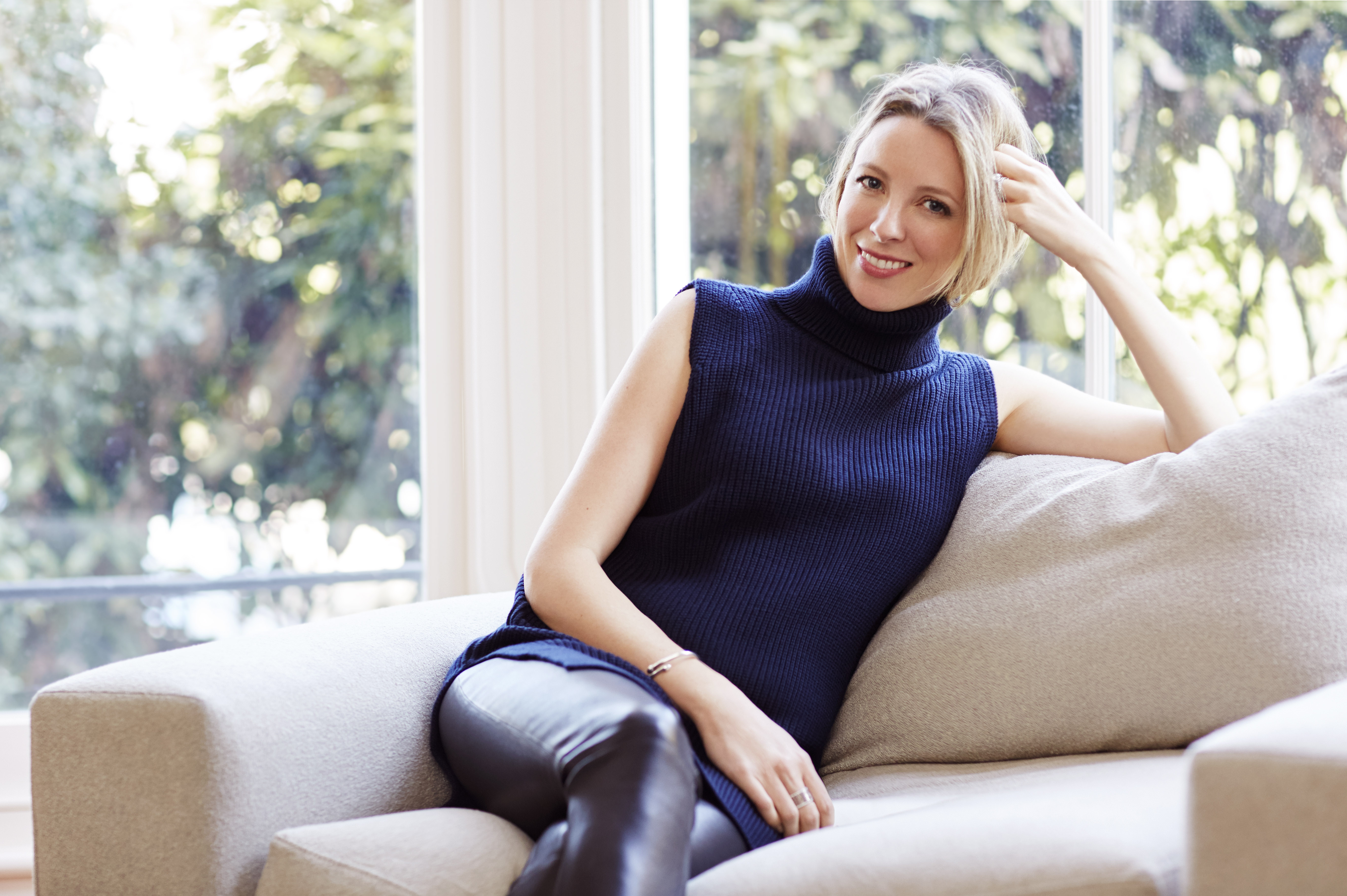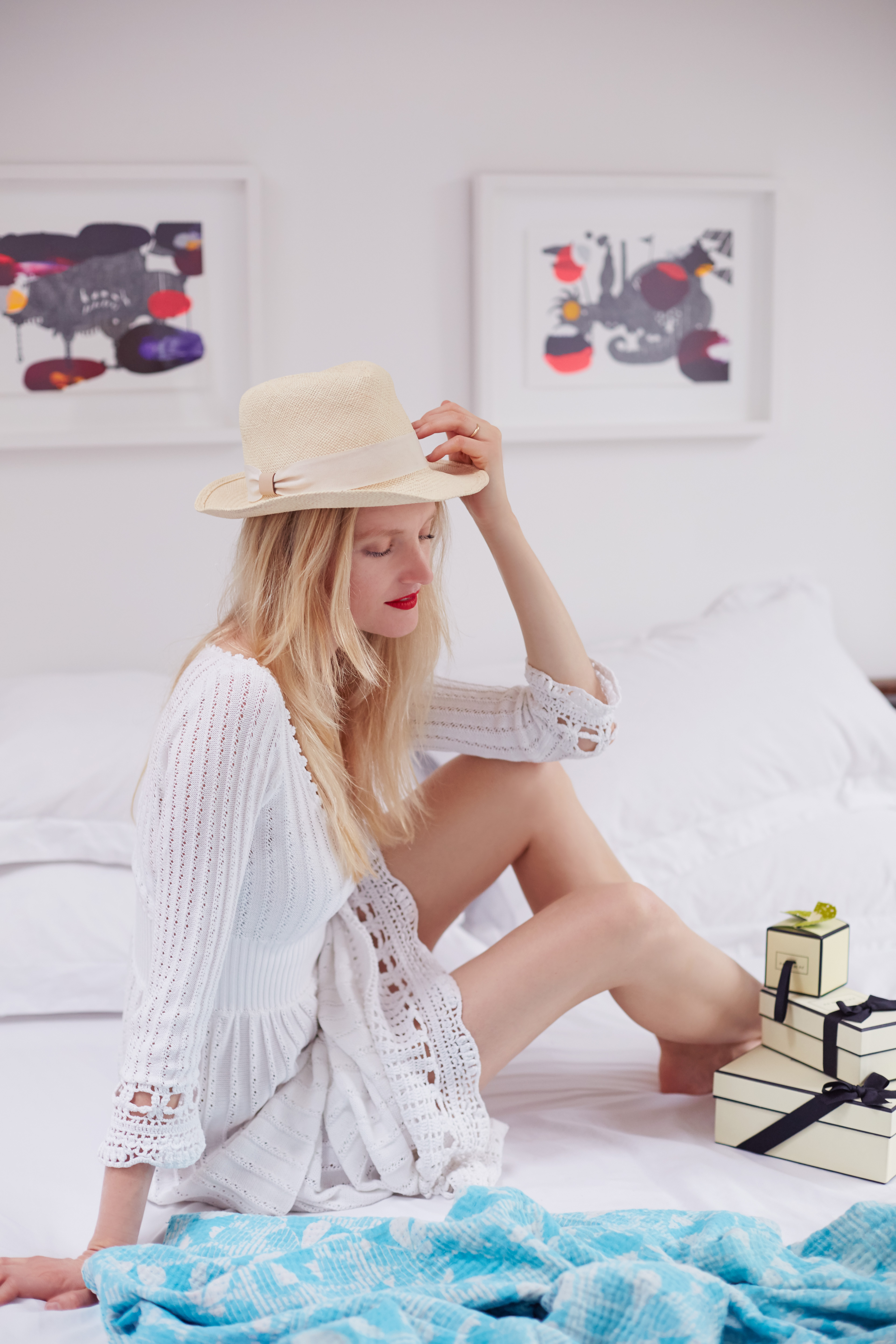I had the great pleasure of shooting Stephanie Phair and her two beautiful daughters Emilia, 2 and Sienna, 1, in their home in West London. Stephanie is the founder and former President of The Outnet, who has been newly appointed as Chief Strategy Officer of Farfetch. She is one of the most inspiring women I have met, juggling both career and motherhood seamlessly with grace.
All portraits by Candice Lake.
Below she explains to Fashionista how her path led her here.
“I studied philosophy, politics and economics — it’s a course called PPE, and it’s kind of the signature course at Oxford, and has nothing to do with fashion. I thought pretty much like everyone else I’d go into management consulting, finance, that kind of thing. So when I decided after college to move to New York, it was sort of for me a bit of a… I’m just going to move to New York, live there for three months, and then come back to London, and get a job at Bain or McKinsey or whichever. Three months turned into 10 years because I decided that, more than anything, I wanted to live in New York. All my life growing up I wanted to be a foreign correspondent, but the draw of New York was even stronger than that.
I was basically just going to have a good time, hang out, I thought I’d get a job as a waitress or something. But it was such a booming time in New York, it was ’99, every dot-com was launching a business, there was a party every night, and the fact that you were a foreigner didn’t matter one bit. They were like oh, start tomorrow, we need you, no problem. This was pre-9/11. In the end I landed at a PR agency, Siren PR, because the founder, called Winnie [Beattie], said, take a job for a few months, I’ll sponsor your visa. I thought she was very grown up and mature, but she was 23. I was doing business development, pitching new clients, doing PR for lifestyle and beauty. There we were, two sort of early-twenties pitching Marc Jacobs. We got LVMH brands, we represented Hard Candy and lots of fun beauty brands.
And then from there I moved on to Issey Miyake, a job I found through a contact. Again, I never saw myself as working in fashion, but I had two jobs back to back that were in that world. Issey Miyake was looking to launch its largest flagship store worldwide, and they needed someone to kind of run all the marketing and communications and positioning. Issey Miyake is a tough brand, it’s very niche, and it’s much more in the world of design and architecture than it is in the world of fashion per se. It was the time when all the brands were linking up with architects to do stores, Prada was launching the Rem Koolhaas store [in New York] at the time, and Issey Miyake partnered with Frank Gehry. So I worked closely with Frank Gehry, and all sorts of young artists that we’d bring in to the flagship store to bring in different sort of customers to the brand. I just figured, it’s a niche brand, and if you can PR and market that, you can pretty much do anything.
To this day I don’t know how it came about, but I got a call from Vogue. They said, we need someone to come and do marketing and PR on the editorial side. To be fair, I’d never been that girl who had dreamt about working for Vogue, at all, but I also knew at that point if you had Vogue on your CV that would really set you up. And it was great, because I worked alongside the events team and very closely with Anna [Wintour], it’s a department she cares a lot about because it’s the positioning of the magazine to world, and it was a great time to be there because we launched the CFDA/Vogue Fashion Fund. I didn’t [report directly to Anna], but what you find at Vogue is that everyone at Vogue reports to Anna, and you always had to be ready and you always knew you’d get that call, even though I was right outside of her office. I would hear her say to her assistants, ‘Get me Stephanie,’ and they’d call me and say, ‘Anna wants you,’ and I’d say, ‘I know, I heard.’
What was great about Vogue was that I really saw the fashion business for the first time as a business. We all know about that now much more than we knew about that then. Back then I think the consumer, in general, saw the fashion business for what the fashion business showed it, which was fashion shows, and designers maybe, and the magazines and the editorials. The consumer, as a whole, didn’t understand the fashion business as a business, and I think you guys and Business of Fashion and all the editors who write about the business have really changed that perception. For me, that perception really changed when I went there. Because Anna has always viewed fashion as a business, from how she connects designers to funding, or how she introduces designers to one of the big conglomerates, or how she sees that retail interacts with Fashion’s Night Out, there’s a real business goal behind it.
So I was at Vogue for about three years, from 2002 to 2005. A lot of people don’t ever want to leave [Vogue]. I wasn’t one of those people. I felt for me the business side was more what I wanted to explore. And I got an opportunity once again through contacts to join an e-commerce startup [called Portero]. The idea was Ebay for luxury. I thought if I was going to do a startup, now was the time. A lot of people were like, ‘Are you crazy to leave Vogue? Are you nuts?’ But for me, I just felt that I would be able to flex different muscles and learn about the business side. I would love to say I was totally a visionary and totally saw the Internet, but I didn’t, it was part luck. It happened to be a business that was e-commerce.
So I ran all product merchandising and business development, basically getting brands and dealers to sell. It was totally new role, totally new contacts. Literally the only reason I was hired is because I knew something about the luxury business, and I think what I said — and I truly believe this — is that PR, done well, is amazing training. Because you learn to sell a story to people who have a lot of stories, a lot of noise. So I basically transferred my PR skills of selling and pitching a story to selling and pitching a concept and a business. I did that for three years. [The company] was bought, it didn’t take off the way that it should have, because it was very early stage, consumers hadn’t gotten their head around this sort of focused marketplace. If you look now, all the businesses that are getting the biggest share in VC funding are pre-owned businesses — the Real Real, Covetique, [Vestiaire] Collective — I can think of 10.
Then personal reasons kicked in, and I moved to London to be with my now-husband [in September 2008]. I ended up marrying an old friend of mine, we’d known each other from the second day of university, and we remained friends throughout, but just friends, and then one day we decided we should be more than friends, and a year later we got married. He was in London, so that’s why I went to London. So it was all very quick. It was time. At some point, everybody has that moment, I’ve done New York, maybe I need a break.
When I moved back to London, an opportunity came up through headhunters. They said, Net-a-Porter is looking for someone to run a new business for them focused on the discount market and they had already done quite a lot of the work, but they need someone to do the launch and run the business and define the strategy and define what the positioning is, etc. I had just been at a startup, and I thought, this is amazing, it’s a startup within an established company. I’m not going to have to worry if there’s ink in the print machine, or if we run out of paper, who’s going to go. I had done a real startup, I knew what it was like to have two people in the office doing everything, and as much as The Outnet was a startup in the early days, there was at least the infrastructure in place, and that allowed us to scale so much faster than we would have if we’d been completely a startup.
Just at that time as I was interviewing, Lehman Brothers crashed, and I remember my husband — who was in finance — said, ‘Look, people are not realizing the impact of this, but you’d better settle on a job now because fast forward three months and everything will dry up.’ And he was right. Starting January 2009, the recession hit big time. We launched [three months] later, which was great timing, but not on purpose. Net-a-Porter had been thinking about doing this for quite some time. They were nearing 10 years, and any business after 10 years normally comes up with some kind of an Outnet strategy. There was this very active sales shopper that was spending a good amount of money, but [Net-a-Porter wasn’t] doing anything with it. So the idea was, let’s spin it off as a standalone website with its own branding and own positioning, and we can really market to that customer and grow that base.
It was a real startup. As much as we had the support of Net-a-Porter, the dedicated staff the day we launched was, like, two. A writer and myself. It took The Outnet and Mr. Porter just four years to achieve the same volume of sales that Net-a-Porter hit in eight. It just goes to show, how quickly new businesses can scale.
We had to set ourselves apart. Gilt was there, and flash sales had already become a little bit of a talked-about phenomenon, but there wasn’t really an outlet online besides Yoox. The idea was to take the DNA of Net-a-Porter and see how that applied to The Outnet. So we positioned ourselves from the beginning as high-end designer, and we were never going to go below that level, really. And then the second thread was editorial. Which now, again, sounds obvious. Everyone does editorial. Back then, even the view was, oh well discount, hey, it’s price, so customers will buy regardless, you don’t need to romance it. But we knew if we led by price, we were not going to win. We had to lead with positioning, editorial, edit, brand selection. What we find is that our customer has a very high household income. She could buy full-price, she does, and so she expects a high level of service, of editorial, that merchandising approach.
When we launched, 80 percent of our stock came from Net-a-Porter, and quickly we realized if we’re going to build a standalone business, we need to buy the stock from the brands, and now we’ve completely flipped and 80 percent of our stock is bought directly by our dedicated buying team from the brands. The buying teams meet with the brands’ commercial teams at market, same as full-price, because it’s a great opportunity to talk about sales, see what’s coming, understand what’s happening at full price. Because the reality is that it’s hard at retail. Obviously it’s a side of retail that brands don’t scream about, but there is a customer out there for it, and it is part of their P&L. We get our merchandise from their wholesale, from their retail, oftentimes we produce stock based on fabric as well. We’ll do exclusive collections, either based on fabric or if they have room for that in their margin. So we have a huge number of ways of working with brands, but the end goal is how can The Outnet be a partner to brands in their goal of selling and growing their business.
One of the biggest forks in the road in the early days was: do we become an open site or do we become a flash sales site? All you heard about was flash sale sites then. Brands were more willing to sell to them because it was behind this velvet rope, and the brands understood the concept of a sample sale online, kind of hidden away, but the reality is that it’s not. And I remember the conversation with [Net-a-Porter founder] Natalie [Massenet], sitting down and talking through it, and I just said, ‘No, we can’t go that route, we won’t win. Our DNA is editorial, the designer brand, merchandising and our authority, and the only way to do that is through an open site,’ so we agreed to do it. But it wasn’t the obvious choice.
Another one was our customer. To be fair, in the early days, The Outnet was positioned for that young, student-y customer with not a lot of money. But very quickly we realized she wasn’t. The average age of our customer is 36, average household income is close to $150,000. She works in finance, in media, in healthcare. She spends on fashion, but the difference is that it’s not her main spend. She travels for leisure six to nine times a year. That says a lot about who our customer is. We knew we needed to rebrand. And you get one chance at a rebrand, not two. So that’s what we did, in 2010, it was a full rebrand.
It took a long time to get brands to work with us, sell to us, partnering with us for collaborations. That took a lot of business development and visits and understanding of what we were doing and our positioning.
[Our private label, Iris & Ink,] wasn’t an idea we had from the beginning. It sort of came about organically. Our in-house styling team was saying, we’ve got these amazing designer pieces, but our customer shops in a way that most of us shop, which is, mix and match. They’re not going to wear head-to-toe Oscar, or head-to-toe Dolce, and we need this basic cashmere to put with that Dolce skirt, and we don’t have that to style with, we have gaps in the offering. So we said, let’s just create it. It started off in 2012 with great, high-quality cashmeres, silk shirts, a go-to black skinny jean. For the first few seasons it was just viewed as a collection, not as a fully fledged brand, but it’s growing nicely, and now’s the time to say this is a brand. It’s definitely within our top 10 bestsellers already. With a brand like that, you’ve got one shot with your customer. If you buy something that doesn’t quite look great, you’ve lost them. We’re looking at other categories that will be their own brand. Potentially [we could do another private label brand], it’s definitely something we think about.”













You Might Also Like..
Level Shoes Dubai | Social Campaign | post
January 2019
0In Bed with… | Jimmy Choo | post
November 2017
0Summer Travel Essentials Jo Malone | post
March 2016
0